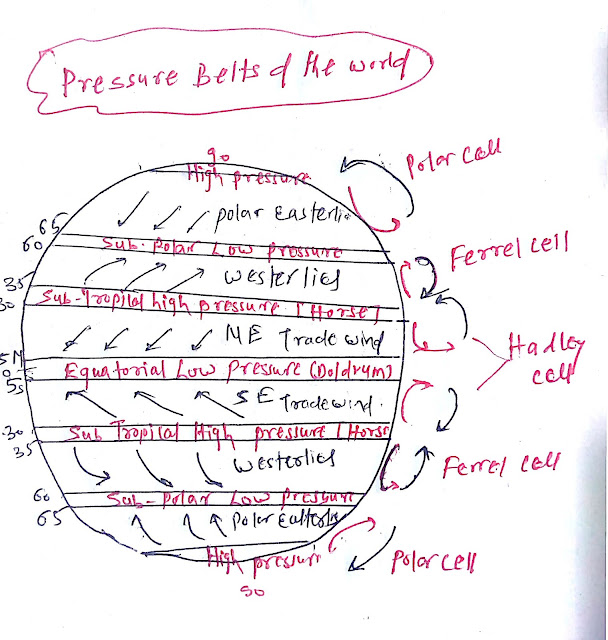Table of Contents:
- Types of Atmospheric pressure belt in the world
- Equatorial low pressure( thermal )
- Location
- Reasons for the formation
- Subtropical high pressure( dynamic)
- Location
- Reasons for the formation
- Sub Polar low pressure(dynamic)
- Location
- Reasons for the formation
- Polar high pressure( thermal)
- Location
- Reasons for the formation
- Atmospheric circulation
- Hadley Cell
- Ferrel Cell
- Polar Cell
Pressure Belts of the world:
As Isobars changes over time, we have seen that January's Isobars are different from July's Isobar. But pressure belt on earth largely remains the same throughout the year, only they shift northward and southward with the apparent movement of the sun. There is 7 number of major pressure belts on the earth, the details of the list are listed below: |
| Pressure belt of the world |
Some important atmospheric pressure belts are:
- Equatorial low pressure( thermal )
- Subtropical high pressure( dynamic)
- Sub Polar low pressure(dynamic)
- Polar high pressure( thermal)
Equatorial low-pressure belt ( thermal-induced)
Location:- It is between 5 degrees north to 5 degrees south.
Low-pressure regions because of two regions:
- High insolation leads air to rise.
- Due to earth rotation, centrifugal force is highest in the equator and lowest in poles. Centrifugal forces also speed up the process of air rise.
Subpolar high atmospheric pressure( Dynamic)
Location:- 30 to 35 degrees north and south in both hemispheres.
Reasons for formation:
- Jetstream from equatorial tropopause and subpolar tropopause sinks in the region creates high pressure.
Subpolar low-pressure belt 60 to 65 degree north and south( Dynamic)
Location:
- 60 to 65 degrees north and south in both hemispheres.
Reasons for formation:
Due to earth rotation, centrifugal force in this region leads to air rise.
Westerlies from the subtropical region and polar easterlies converse here and lead to the creation of low pressure.
Polar high-pressure Belt ( Thermal)
Location:- 90 degrees North and south.
Reasons for formation:
- In poles, centrifugal force is nearly zero, hence a high-pressure belt at poles is not dynamically induced.
- In this region, cold air sinks, due to the sinking of cold air, the high-pressure belt is created, it is thermally induced ( because of cold air).
Atmospheric circulation
The distribution of atmospheric heats is done by the movement of large-scale air; large-scale air movement is called atmospheric circulation.
There are three major types of atmospheric cells in each hemisphere; there is a total of 6 major cells on earth.
 |
| Atmospheric circulation |
Tropical or Hadley cell:
- Equatorial air rises Upto tropopause and flows like a jet stream to both hemispheres and sinks at 30 to 35 degrees latitude. In surface, winds move as trade winds from 30-degree latitude in both hemispheres to the equator and again air rise and sink to 30-degree latitude, by this process, circular motion of trade winds in surface to jet stream in higher latitude from equator to 30-degree latitude in both hemispheres is called Hadley cell.
Temperate or Ferrel cell:
- Westerly flow from 35-degree latitude to 60-degree latitude in both hemisphere, air rises from 60 to 65-degree latitude and flow in higher latitude and sink at 30 to 35-degree latitude, this circular motion of air, is called Temperate or Ferrel cell.
Polar cell:
- The circular motion of air from poles to the subpolar low-pressure belt is called a polar cell.
- As per Ferrel and by Coriolis force, winds in the northern hemisphere deflect right, and in the southern hemisphere winds deflect left.
Doldrums:
- The calm region between 5 degrees north to 5 degrees south where the trade winds convergence at the equator is called the doldrums.
Horse latitude:
- Between 30 to 35 degrees in both hemispheres is called horse latitude where the air sink.
ConversionConversion EmoticonEmoticon